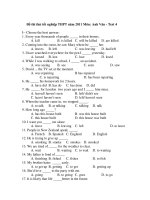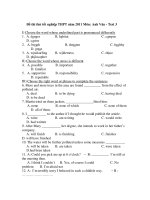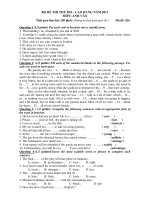ĐỀ THI THỬ HSG LẦN 1 NĂM 2011 MÔN: ANH VĂN ppt
Bạn đang xem bản rút gọn của tài liệu. Xem và tải ngay bản đầy đủ của tài liệu tại đây (47.45 KB, 3 trang )
ĐỀ THI THỬ HSG LẦN 1 NĂM 2011
MÔN: ANH VĂN
PART 1: VOCABULARY & READING
Task 1: Complete the following sentences using the words in the box.
1. They are going on a(n) ____________ across the Sahara desert next summer.
2. In 1936, Colson and an Australian Aborigine traveled ____________ the Simpson
Desert by camels.
3. Within the last 100 years, deserts have been growing at a(n) ____________ speed.
4. The Simpson desert remained a mystery until Madigan made an aerial
____________ in 1929.
5. The road and the canal run ____________ to each other.
6. The Sahara is a great ____________ in the northern part of Africa.
7. He draw a(n) ____________ by running a pencil around the lid of a jar.
8. Many countries build long ____________ to bring water to the desert areas.
9. Mekong Delta is ____________ in the Southwest of Vietnam.
10. Desert is a hot, dry and ____________ place.
Task 2: Choose the best answer of A, B, C or D to complete the following sentences.
1. A new bridge was built ____________ the river.
A. on B. cross C. across D.
along
2. A voyage of discovery is a(n) ____________ .
A. picnic B. trip C. excursion D.
expedition
3. The ____________ of the spider web hung across the broken window was full of
flies.
A. network B. curtain C. sheet D.
string
4. On the ____________ of the hill stands a big white house.
A. neck B. crest C. head D.
height
5. Most classrooms and apartments open out onto ____________.
A. doors B. hills C. windows D.
corridors
6. The door is three feet ____________ and six feet high.
A. wide B. deep C. fat D. tall
7. The ____________ features in the desert are arid land and dry climate.
desert
survey
natural
parallel
sandy
circle
located canal expedition across separates frightening
A. nature B. natural C. naturally D.
natured
8. In 1939 Madigan led a ________ expedition across the sand dunes on a more
northerly route.
A. science B. scientist C. scientific D.
scientifically
9. Humans and nature cause the change in the size and ____________ of the world’s
deserts.
A. location B. locate C. located D.
locating
10. America is ____________ from Europe by the Atlantic Ocean.
A. paralleled B. lied C. located D.
separated
Task 3: Choose the answer of A, B, C, or D to complete the following passage.
Deserts are described as areas that get an average of less than ten inches of rain a
year. In the (1)______, temperatures may soar to over 120 degrees during the days,
but will drop (2)_______ the sun sets. Winters may be cold. The dry desert air and
clear skies do not hold onto the heat at night.
Some plants are annuals. Their seeds wait in the ground for years until there is a
(3)______ winter: then they sprout rapidly and grow as fast (4)______ they can. They
race the sun to make seeds before the water evaporates and the heat dries them up.
Some of these plants are (5)_______ tiny that the whole plant could be hidden under
a dime. Others spread colorful blossoms over the sand and rocks for a few brief days.
1. A. spring B. summer C. autumn D.
winter
2. A. before B. while C. until D.
during
3. A. rainy B. sunny C. windy D.
cloudy
4. A. than B. that C. so D. as
5. A. so B. such C. too D.
enough
Task 4: Choose the item among A, B, C or D that best answers the following
questions about the passage.
The deserts of the world are not all covered with sand. Many of them have
surfaces of rock or clay or small stones. They are not flat, either; they often have high
hills and deep valleys. There is some plant life in many parts of the desert. There is
little rain in the desert, but it does fall enough for most plants.
The deserts of the world are not uninhabited. People also live outside oases, but
these people are not farmers. They have camels, goats, donkeys, sheep, etc. These
animals can live on the desert plants and do not need much water.
The people of the desert have to move constantly from place to place, they must
always look for grass or desert plants for their animals. They usually live in tents.
When there is no more food for their animals, they fold up their tents, put them on
their camels and donkeys, and move to another place. In good years, when there is
enough food for their animals, they trade their skins and their goats and camel hairs
with the people of oases for wheat and fruit. But in bad years, when there is not
enough food for their animals, the people of the desert would attack the oases people.
But they are also hospitable. No man in the desert would ever refuse to give stranger
food and water.
1. According to the passage, deserts are mostly made up of ________________
A. clay B. rock C. sand D.
stones
2. In the desert ____________________________________________________
A. it rains in spring only B. it
rains for a short time every month
C. there is some rain, but far from enough D. the rainfall is just enough for
the plants.
3. People live _____________________________________________________
A. only inside the oases B. only outside the oases
C. both inside and outside the oases D. in places with regular rainfalls
4. The world “hospitable” has the meaning of being ______________________
A. brave B. cruel C. strange D. kind
5. From the passage we know that life __________________________________
A. is hard in deserts B. is happy in deserts
C. is impossible in deserts D. in deserts is much better now









